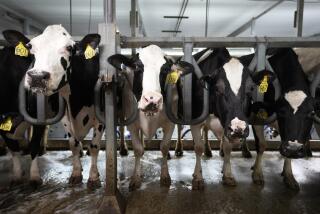Cow Madness in England
- Share via
Britain, like California, enjoyed a food boom in the 1980s and ‘90s. British cookery became “modern British cooking.” Newspapers that once had mere food columns suddenly had food pages. Television companies threw rare characters into the soup: the Two Fat Ladies, the Naked Chef and the shimmying Ainsley Harriot.
But for all the exuberance, the same period brought a profound erosion of substance. Traditional butchers, bakers and fishmongers were replaced by supermarkets. A generation of home cooks who routinely saw whole carcasses carried into butcher shops were replaced by food fanciers who never even saw a trotter. Grandmothers who made stock each week have been replaced by granddaughters who make restaurant reservations. Today, most Britons live so far from farms that a school child could be forgiven for thinking chickens come in polystyrene trays and consist of six legs.
The realization that meat comes from animals is mainly driven home on TV, usually during reports of disease epidemics, when nightmare images of carcasses involved in foot-and-mouth and mad cow culls take over the media. Since 1996, these images have been so constant that they have become Britain’s answer to Southern Californian car chases. The current epidemic of foot-and-mouth disease will take months, possibly years, to extinguish. After a decade of mad cow disease, to the tired eyes of Britons, agriculture is a smoldering disaster zone.
By 1997, market research conducted among the British public showed them already so worried about the microbial content of meat that the UK’s leading supermarket chain, Sainsbury’s, began carrying chopping boards and food storage containers impregnated with anti-microbial agents.
While consumers are full of anxiety about unnatural practices in food production, in this country as well as the United Kingdom, very few know the ABCs of routine farm life. Great Britain is one of the largest dairy-producing countries in Europe, but the average Briton has no idea why the country every year produces at least half a million unwanted veal calves.
In 1996, animal rights demonstrations erupted against the export of these calves at Kent seaports. “Absolutely Fabulous” actress Joanna Lumley was the public face of the protesters.
At the same time, she was starring in a prominent series of yogurt commercials. It went unremarked that yogurt is made from milk, that cows have to calve to produce this milk; that half of those calves will be bulls, which cannot be milked; and that it was those redundant bull calves that were being shipped to veal producers in France. No, this was seen merely as something nasty that farmers do to defenseless animals.
Today, as British farmers reel under the double whammy of mad cow and foot-and-mouth epidemics, an indignant urban media has responded as if they had it coming. The Observer newspaper has even blamed farmers for plummeting tourism during foot-and-mouth disease quarantines. “Tourism-worth [$94.5 billion] a year-is being crippled by the moves to protect livestock exports, worth [$1.8 billion] a year,” wrote Anthony Browne.
In the Guardian, the paper’s restaurant critic became a back-seat veterinarian. “Last week we killed 25,000 cattle, pigs and sheep,” wrote Matthew Fort. “Why? Foot-and-mouth disease is no threat to humans. It isn’t much threat to the animals either. Most would recover if the disease were let to run its natural course.”
This is absurd, says international foot and mouth authority Fred Brown of the U.S. Department of Agriculture. Plum Island Animal Disease Center in New York. But in newspaper offices and television studios, livestock disease isn’t a science, or a fact of life, or part and parcel of food production. It’s someone’s fault. In the wake of foot and mouth, the Observer newspaper even ran a “Who is to Blame?” quiz.
In the New Statesman, writer David Cox argues that the country’s farmers should just buzz off “and take their disgusting diseases with them.”
Here in the United States, the mood is almost as nasty. This paper’s opinion pages last week carried articles declaring that modern farms are frat parties for germs and laid blame for foot and mouth at the door of agribusiness. The authors, from the Worldwatch Institute in Washington, D.C., were unaware that most of Britain’s affected farms are small family-owned businesses where the livestock graze open pasture and are not packed in the “unhygienic warehouses” described in the diatribe.
Bill Maher has taken to declaring that “mad cow disease is a good thing” on his late-night ABC show “Politically Incorrect.” Maher disapproves of eating meat, and there are some good arguments to be made that we should eat less. But ironically for such a notionally hip character, he speaks about omnivores in much the same tones that some right-wing Christian fundamentalists reserve for gays with AIDS.
The basic difference separating the people who feed us from the chattering classes is that farmers and cooks are bound by laws of nature. Milk comes from cows, beef from steers, eggs from hens, etc. These products have to meet certain standards and pass repeated inspections.
But pundits can say whatever they like. Pigs might fly. So few of us have agricultural experience these days, whatever they say can be believed by millions and repeated for years before anyone who has even, say, set foot on a farm might move to correct it.
Writers like David Cox in the British New Statesman magazine think the U.K. would be better off without farmers. Britain’s is a “knowledge economy,” he avers. Farming is very World War II; the danger of food shipments being intercepted by German U-boats is past. “Instead of struggling to feed ourselves from our own puny acreage, we should buy in the best and cheapest food that the world can provide,” he says.
He doesn’t explain how they would know what they were eating once they unpacked it.
More to Read
Sign up for Essential California
The most important California stories and recommendations in your inbox every morning.
You may occasionally receive promotional content from the Los Angeles Times.













